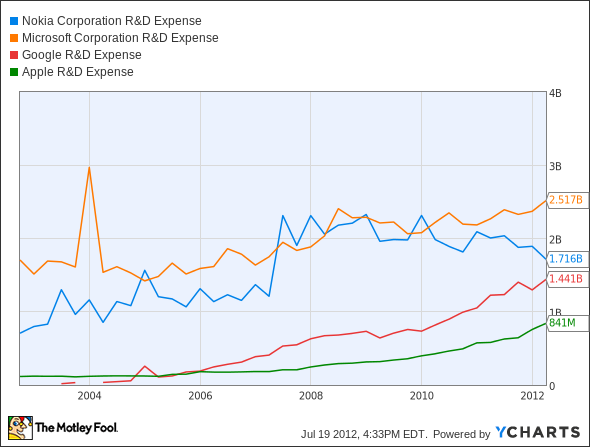As much as I try not to argue with my three friends woulda, coulda, and shoulda, because they always seem to win, sometimes you just can’t help but wonder how things woulda, coulda, and shoulda been.
A trip down memory lane
Go back at least seven years before Apple (Nasdaq: AAPL) would launch its industry-changing iPhone. In Nokia’s (NYSE: NOK) labs, it had built a phone that featured a color touch screen with just a single button located beneath it. Around the same time, it had also built a prototype of a tablet computer with wireless data connectivity that also utilized a touch screen. Of course, those characteristics all describe the iPhone and iPad that consumers have come to love and are ditching their Nokia devices in favor of.
The Wall Street Journal describes Nokia’s ex-design chief, Frank Nuovo, who was even amazed at how spot-on the company’s ideas were at the time: “Oh my God. We had it completely nailed.”
Neither device ever reached the market but, instead, both were kept in Nokia’s research labs awaiting commercialization. Without commercialization, innovation is fruitless for the company that develops it, and wasteful for shareholders who inevitably foot the R&D bill. Nokia was held back by organizational infighting that stood between its research and bringing a device to market.
It also didn’t help that Nokia made the ill-timed decision to focus more on feature phones, aka dumbphones, at a time when smartphones were clearly the future. One former exec said, “The Nokia bias went backwards. It went toward traditional mobile phones.”
Dragging feet
This failure to act was also noted by other partners. For example, Qualcomm’s (Nasdaq: QCOM) Snapdragon mobile application processors are the only chipsets supported by Windows Phone, meaning that Nokia would inevitably need to collaborate with the chipmaker for its all-in bet on Windows Phone, after the two settled some outstanding patent litigation. Qualcomm CEO Paul Jacobs recalled:
What struck me when we started working with Nokia back in 2008 was how Nokia spent much more time than other device makers just strategizing. We would present Nokia with a new technology that to us would seem as a big opportunity. Instead of just diving into this opportunity, Nokia would spend a long time, maybe six to nine months, just assessing the opportunity. And by that time the opportunity often just went away.
Money not well spent
Interestingly, a reputation for impressive R&D projects that cost a ton of shareholder dollars and may never see the light of day is also something Nokia’s current smartphone partner Microsoft (Nasdaq: MSFT) is known for. Microkia vastly outspent other mobile rivals over the past ten years, and has little to show for it in terms of market share in the current landscape.
NOK R&D Expense data by YCharts
Both Google (Nasdaq: GOOG) and Apple now effectively own the smartphone market and have spent much less in R&D.
Crunch time
All companies inevitably spend a long time on new product categories, and it’s hard to say precisely when Apple began working on the iPhone and iPad in its own labs. One interesting outcome of Apple’s current court battle with Samsung is the release of some photos of original iPad prototypes that date back to as early as 2002, when design chief Jony Ive began working on it, unearthed within court documents by Network World:

Source: Network World.
One thing’s for sure though: if Nokia had hunkered down when it was crunch time, and focused on getting innovative ideas out the door, it wouldn’t be where it is now. Now, it’s really crunch time.
Nowadays rivals don't typically have much luck competing directly with Apple's iPhone, which is one reason it has the potential to keep on running. Our brand-new premium Apple research service will tell current and prospective shareholders everything they need to know about the iPhone maker, so sign up now. We're now more than halfway through 2012, but it's also not too late to check out The Motley Fool's Top Stock for 2012. This retailer employs a familiar business model but is taking it south of the border. This report is totally free.

